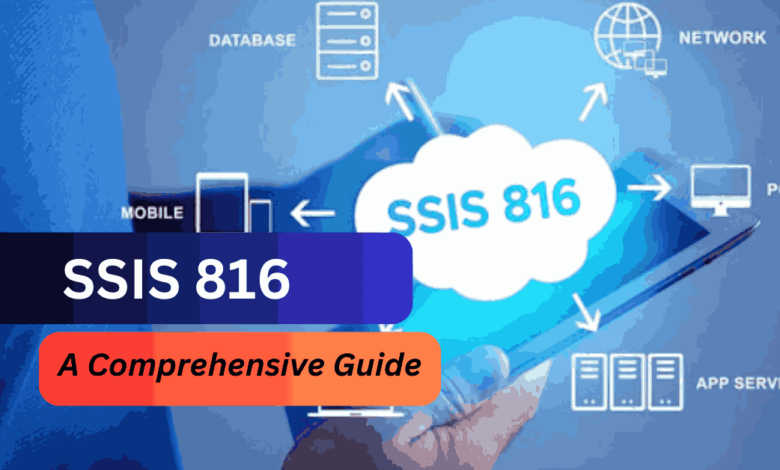SSIS 816 – A Comprehensive Guide! In 2024

In today’s world where data is crucial, managing it well is really important for businesses to succeed. That’s where SSIS 816 comes in. It’s a newer version of SQL Server Integration Services made by Microsoft. SSIS 816 helps users make tasks like getting data, changing it, and putting it into databases much easier and more reliable.
SSIS 816, or SQL Server Integration Services, is a powerful data integration tool developed by Microsoft. It facilitates data extraction, transformation, and loading across various systems and databases.
In this comprehensive guide, we’ll delve into the intricacies of SSIS 816, exploring its components, features, benefits, real-world applications, and common issues.
What is SSIS 816?
SQL Server Integration Services, commonly known as SSIS, has been a cornerstone of Microsoft’s data management ecosystem for years. With each iteration, it has evolved to meet the growing demands of data-driven businesses.
Among its latest releases, SSIS 816 represents a significant leap forward in data integration capabilities, offering many features and enhancements designed to streamline data workflows and enhance productivity.
Understanding SSIS 816 Components – Explore SSIS 816 Components Today!
SSIS 816 comprises several essential components that work synergistically to facilitate seamless data integration. Let’s delve deeper into each component to understand its functionality and significance comprehensively:
1. Control Flow:
The control flow component of SSIS 816 serves as the orchestrator of data integration processes. It employs a robust control flow engine to coordinate the execution of tasks, workflows, and data containers within SSIS packages.
By defining precedence constraints and workflow logic, users can ensure the orderly execution of operations, enabling efficient data movement across integrated systems. From conditional branching to looping structures, the control flow component empowers users to design complex data integration workflows with precision and flexibility.
2. Data Flow:
Central to any ETL process, the data flow component of SSIS 816 facilitates the movement, transformation, and manipulation of data. It provides a visually intuitive environment where users can design data flow pipelines to extract data from various sources, perform transformations, and load data into destination systems.
With a wide range of transformation tasks and data processing capabilities, including sorting, aggregating, and merging, the data flow component empowers users to manipulate data with precision and agility. Additionally, SSIS 816 offers advanced features such as error handling and data lineage tracking, ensuring data integrity and reliability throughout the integration process.
3. Integration Catalog:
The integration catalog serves as a centralized repository for SSIS packages, providing a unified platform for package management and administration. It enables users to efficiently organize, deploy, and execute SSIS packages, streamlining the deployment lifecycle.
With features such as version control, logging, and monitoring, the integration catalog empowers users to track package execution, troubleshoot errors, and maintain package integrity effectively. Moreover, the integration catalog facilitates seamless collaboration among multiple users, enabling team-based development and deployment of SSIS solutions.
4. Scripting:
SSIS 816 offers scripting capabilities and custom components, allowing users to extend the functionality of SSIS packages through custom code and scripts. Whether implementing complex data transformations or integrating with external systems, scripting allows users to tailor SSIS solutions to their specific requirements.
With support for scripting languages such as C# and VB.NET, users can leverage the full power of the .NET framework to implement custom logic and functionality within SSIS packages. From data validation to custom logging, scripting empowers users to enhance the capabilities of SSIS and address unique integration challenges effectively.
By understanding the core components of SSIS 816 and their respective functionalities, users can harness the full power of SQL Server Integration Services to streamline data integration processes, optimize performance, and drive business success.
Unlocking The Power Of Ssis 816 Features – Don’t Miss Out On The Opportunity To Supercharge!
SSIS 816, or SQL Server Integration Services, represents a significant leap forward in data integration and management. Its robust features empower users to tackle complex data challenges with confidence and efficiency. Let’s delve deeper into the key features of SSIS 816 and explore how they contribute to unlocking its full potential:
1. Simple Interface:
Despite its advanced capabilities, SSIS 816 boasts a user-friendly interface that caters to users of all skill levels. Whether you’re a seasoned data engineer or a novice user, navigating SSIS 816 is intuitive and straightforward.
The streamlined interface enables users to design, deploy, and monitor ETL processes with ease, eliminating the steep learning curve associated with traditional data integration tools.
2. Improved Connectivity:
One of the standout features of SSIS 816 is its unparalleled connectivity options. From relational databases to cloud storage solutions, SSIS 816 supports a wide range of data sources, enabling seamless integration across heterogeneous environments.
Whether you’re extracting data from on-premises systems or streaming data from the cloud, SSIS 816 provides the flexibility and agility needed to meet the demands of modern data ecosystems.
3. Enhanced Data Transformation:
Data transformation lies at the heart of SSIS 816, and its capabilities in this regard are truly impressive. With a comprehensive set of transformation tools and functions, users can manipulate data in myriad ways to meet their specific requirements.
Whether you’re performing simple cleansing tasks or implementing complex business logic, SSIS 816 empowers you to transform raw data into actionable insights with precision and efficiency.
4. Advanced Performance:
Performance is paramount in data integration, and SSIS 816 delivers on this front with flying colors. Leveraging advanced parallel processing techniques, SSIS 816 maximizes throughput and minimizes latency, ensuring swift and efficient data movement.
Whether processing large volumes of data or handling real-time streams, SSIS 816 provides the performance and scalability needed to keep pace with your evolving data needs.
5. Advanced Data Safety Measures:
Security is a top priority in data integration, and SSIS 816 takes this aspect seriously. With robust encryption, authentication, and access control mechanisms, SSIS 816 safeguards sensitive data throughout the integration lifecycle.
Whether dealing with personally identifiable information or proprietary business data, SSIS 816 ensures that your data remains secure and compliant with industry regulations.
6. Improved Data Cataloging:
SSIS 816 streamlines data governance and management with its robust metadata capabilities. By maintaining a centralized catalog of data assets, SSIS 816 provides users with a comprehensive view of their data landscape, facilitating easier discovery, access, and utilization of data assets.
Whether managing structured datasets or unstructured files, SSIS 816 helps you stay organized and in control of your data assets.
Explore The Power Of Ssis 816 – Unlock Real-World Solutions Today!
SIS 816, with its robust features and versatile functionality, finds extensive applications across various industries and use cases. Let’s delve deeper into some specific real-world scenarios where SSIS 816 plays a pivotal role:
E-commerce Data Management:
In the fast-paced world of e-commerce, managing vast amounts of data related to products, customers, orders, and inventory is crucial for success. SSIS 816 enables e-commerce businesses to streamline data extraction, transformation, and loading processes.
For instance, it facilitates the integration of data from multiple sources, such as online storefronts, inventory management systems, and customer relationship management (CRM) platforms. By efficiently managing e-commerce data, businesses can gain valuable insights into customer behavior, optimize product offerings, and enhance operational efficiency.
Healthcare Information Systems:
Healthcare facilities, including hospitals, clinics, and medical laboratories, rely on SSIS 816 to manage and integrate complex healthcare data. SSIS 816 simplifies the process of aggregating and analyzing disparate healthcare datasets, from patient records and medical imaging files to billing and administrative data.
By ensuring seamless data integration and interoperability across different healthcare information systems, SSIS 816 facilitates better clinical decision-making, improves patient care coordination, and enhances overall healthcare outcomes.
Financial Data Integration:
Financial institutions, such as banks, investment firms, and insurance companies, leverage SSIS 816 to handle large volumes of financial data efficiently. SSIS 816 enables seamless data integration from diverse sources, including transactional systems, market data feeds, and regulatory compliance databases.
SSIS 816 helps financial organizations enhance risk management, compliance reporting, and financial analysis processes by automating data extraction, transformation, and loading tasks.
Moreover, SSIS 816’s advanced data security features ensure the confidentiality and integrity of sensitive financial information, thereby safeguarding against data breaches and fraud.
Retail and Supply Chain Management:
Retailers and supply chain organizations utilize SSIS 816 to optimize inventory management, supply chain logistics, and demand forecasting processes. SSIS 816 facilitates the integration of data from various sources, such as point-of-sale (POS) systems, inventory databases, and supplier portals.
SSIS 816 enables retailers to make data-driven decisions that enhance customer satisfaction and operational efficiency by synchronizing inventory levels, tracking product movements, and analyzing sales trends in real-time. SSIS 816’s ability to automate data workflows and schedule tasks also ensures timely and accurate data updates across the retail and supply chain ecosystem.
Marketing and Customer Relationship Management (CRM):
Marketing departments and CRM teams leverage SSIS 816 to consolidate customer data, segment target audiences, and execute personalized marketing campaigns. SSIS 816 integrates data from various marketing channels, including websites, social media platforms, email marketing tools, and customer databases.
By centralizing customer information and analyzing behavioral data, SSIS 816 enables marketers to tailor marketing messages, track campaign performance, and measure ROI effectively.
Moreover, SSIS 816’s scalability and flexibility empower organizations to adapt to evolving marketing trends and customer preferences, ensuring long-term competitiveness in the marketplace.
Addressing Common Ssis 816 Issues And Implementing Best Practices – Optimize Your Workflow!
While SSIS 816 offers unparalleled functionality, users may encounter common issues during implementation. Here, we’ll delve deeper into these issues and provide best practices for mitigating them effectively:
Connection Settings:
- Issue: Misconfigured connection settings can lead to data transfer failures, hindering the seamless flow of information between systems.
- Best Practice: Double-check connection strings, authentication credentials, and network configurations by ensuring alignment between connection settings and target databases. Conduct thorough testing to verify connectivity and address any discrepancies proactively.
Poorly Designed Packages:
- Issue: Inefficiently designed SSIS packages can result in slow performance, processing bottlenecks, and maintenance challenges.
- Best Practice: Adhere to best practices in package design, such as modularization, reuse of components, and encapsulation of logic.
Optimize package structure and workflows to minimize complexity and improve scalability. Implement error handling and logging mechanisms to facilitate troubleshooting and maintenance.
Data Conversion Errors:
- Issue: Data type mismatches and conversion errors can disrupt data integration workflows, leading to inconsistencies and inaccuracies in processed data.
- Best Practice: Conduct thorough data profiling and analysis to identify potential data type mismatches and conversion challenges. Standardize data formats and implement data validation routines to ensure consistency and integrity. Utilize SSIS data conversion tasks and transformation components effectively to handle diverse data types and formats.
Performance Bottlenecks:
- Issue: Performance bottlenecks can arise due to inefficient query execution, resource contention, and suboptimal package design.
- Best Practice: Profile package performance using SSIS logging and performance monitoring tools to identify performance bottlenecks and optimization opportunities.
Implement performance tuning techniques, such as parallel processing, batch processing, and indexing, to improve query performance and throughput. Optimize data flow pipelines by minimizing data movement and leveraging in-memory processing capabilities.
Error Handling and Logging:
- Issue: Inadequate error handling and logging mechanisms can impede troubleshooting efforts and hinder visibility into package execution.
- Best Practice: Implement robust error handling and logging mechanisms within SSIS packages to capture and report errors effectively.
Utilize SSIS event handlers, logging providers, and error output paths to record detailed information about package execution, including error messages, data flow statistics, and execution metrics.
Configure package logging levels and verbosity settings to balance information granularity and performance overhead.
By adhering to these best practices and proactively addressing common issues, users can maximize the efficiency and effectiveness of SSIS 816 in their data integration endeavors, ensuring seamless data movement and accurate processing.
Difference Between DTS And SSIS – Take Your Data Integration To The Next Level!
In data integration, understanding the differences between Data Transformation Services (DTS) and SQL Server Integration Services (SSIS) is crucial for making informed decisions regarding data management strategies.
While DTS and SSIS serve similar purposes of extracting, transforming, and loading data, they exhibit significant disparities in functionality, architecture, and capabilities. Let’s delve deeper into the evolution and distinctions between DTS and SSIS:
1. Architectural Variations:
- DTS (Data Transformation Services): DTS was introduced as part of Microsoft SQL Server 7.0 and continued through SQL Server 2000. It primarily consisted of objects and utilities used for data extraction, transformation, and loading. DTS packages were created and managed within SQL Server Enterprise Manager.
- SSIS (SQL Server Integration Services): SSIS succeeded DTS with the release of Microsoft SQL Server 2005. Unlike its predecessor, SSIS features a more robust and extensible architecture built on the Microsoft .NET framework.
SSIS packages are authored using SQL Server Data Tools (SSDT) or Business Intelligence Development Studio (BIDS), offering enhanced development capabilities and flexibility.
2. Extensibility and Customization:
- DTS: While DTS provided basic transformation and workflow capabilities, its extensibility was limited. Users had access to a predefined set of tasks and transformations, with limited options for customization beyond scripting.
- SSIS: SSIS introduced a more extensible and customizable framework, allowing developers to create custom tasks, components, and data flow transformations using managed code. This enhanced extensibility enables organizations to tailor SSIS solutions to their specific requirements, leveraging the full power of the .NET framework.
3. Integration and Connectivity:
- DTS: DTS offered connectivity to a limited range of data sources and destinations, primarily focusing on Microsoft SQL Server databases. While it supported OLE DB and ODBC connections, integration with non-SQL Server systems was often cumbersome.
- SSIS: SSIS significantly expanded connectivity options, supporting various data sources and destinations, including relational databases, flat files, XML, Excel, and more. With native support for diverse data formats and protocols, SSIS simplifies integration with Microsoft and non-Microsoft platforms, enhancing interoperability and data exchange capabilities.
4. Performance and Scalability:
- DTS: DTS packages were executed in-process within the SQL Server environment, limiting scalability and performance optimization options. Large-scale data transformations and processing tasks often suffer from performance bottlenecks.
- SSIS: SSIS introduced a more scalable and performance-oriented execution model, leveraging parallel processing and multithreading capabilities. SSIS packages can be executed in a separate runtime environment, offering enhanced performance and scalability for complex data integration scenarios.
5. Management and Monitoring:
- DTS: DTS lacked robust management and monitoring features, making it challenging to track package execution, troubleshoot errors, and manage deployment across environments.
- SSIS: SSIS provides comprehensive management and monitoring capabilities through SQL Server Management Studio (SSMS) and SQL Server Integration Services Catalog. Administrators can quickly deploy, schedule, monitor, and manage SSIS packages, ensuring efficient execution and maintenance of data integration workflows.
Frequently Asked Questions (FAQs):
1. What are the key components of SSIS 816?
SSIS 816 comprises control flow, data flow, integration catalog, and scripting components, each crucial in facilitating seamless data integration processes.
2. How can businesses benefit from using SSIS 816?
Businesses can leverage SSIS 816 to streamline data management processes, improve connectivity, enhance data transformation capabilities, and bolster security measures, ultimately driving efficiency and productivity.
3. What are some common issues with SSIS 816?
Common issues with SSIS 816 include connection settings misconfiguration, poorly designed packages, and data conversion errors. Adhering to best practices and thorough testing can help mitigate these issues effectively.
4. What industries can benefit from SSIS 816?
SSIS 816 finds applications across various industries, including e-commerce, healthcare, finance, and more. Its versatility and robust features make it an indispensable tool for organizations seeking efficient data integration solutions.
Conclusion:
In conclusion, SSIS 816 stands as a formidable tool in the realm of data integration, offering unparalleled functionality, performance, and reliability. By harnessing the power of SSIS 816, businesses can streamline their data management processes.
As organizations continue to navigate the complexities of the data-driven landscape, SSIS 816 remains an indispensable ally in achieving data efficiency and success.



